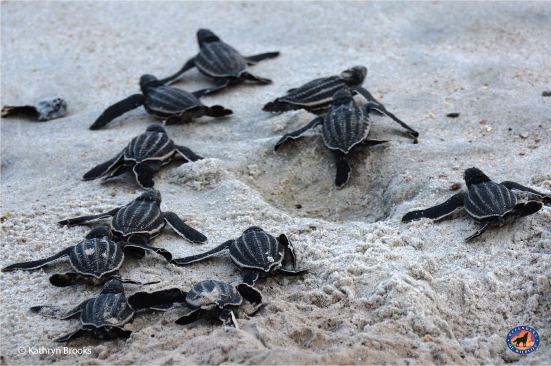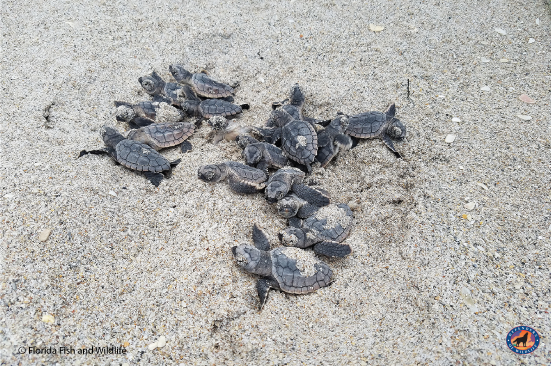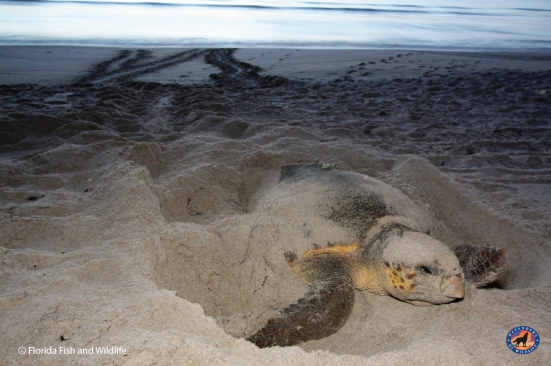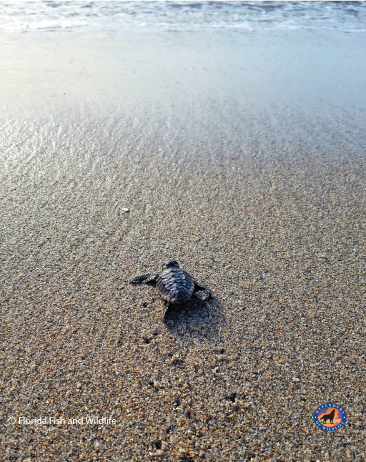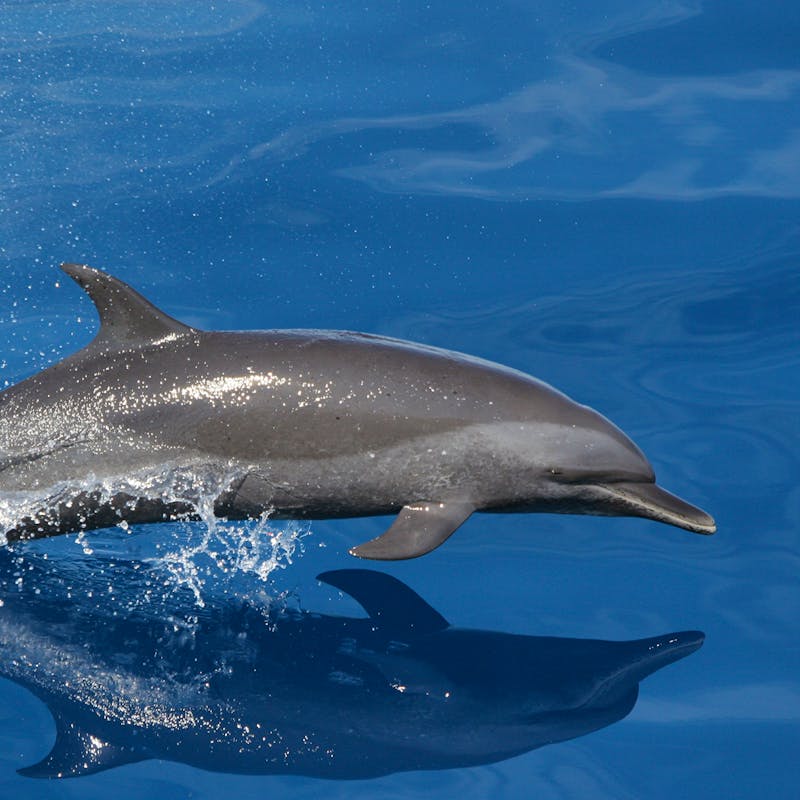Keeping an eye out for nesting sea turtles in Florida–what you can do to help them survive.

Sea turtles are some of the Earth’s most ancient creatures and have called our oceans home for an astonishing 110 million years! But the world’s remaining seven sea turtle species face intensifying threats to their survival. Of these species—loggerhead, green, Kemp’s ridley, olive ridley, hawksbill, leatherback and flatback—all but the flatback (found only in Australia and Papua New Guinea) are found in U.S. waters and are listed as threatened or endangered under the Endangered Species Act (ESA). Of these six sea turtle species, five are known to use the beaches and waters around Florida as key habitat, especially for nesting.
Florida is globally important to sea turtles
The southeastern United States hosts the world’s largest nesting aggregation of loggerhead turtles; Florida’s beaches account for approximately 90 percent of these nesting sites. Florida’s green turtle nesting aggregation is the second largest in the Western Hemisphere. Florida is the only state in the continental U.S. where leatherback turtles regularly nest. A few Kemp’s ridley and hawksbill turtles also lay their eggs on Florida beaches each year.
In the 2016 sea turtle nesting season, the Florida Fish and Wildlife Conservation Commission documented more than 120,000 loggerhead nests, more than 5,000 green turtle nests and over 1,000 leatherback nests on Florida beaches.
Nesting season is in full swing
Nesting season begins in March on the Atlantic coast and in late April or May along the Gulf coast, and can last into November. During nesting season, female sea turtles come ashore at night to dig nests and lay their eggs in the sand. About 60 days later, the tiny hatchlings emerge from the nest as a group, orient themselves to the brightest horizon, and rush towards it. On natural beaches, the brightest light comes from reflections from the moon and stars over the water, guiding the turtles towards the ocean.Unfortunately, beachfront lighting from houses, condos, hotels, street lamps and many other sources can disorient hatchlings as well as adults. Artificial lights can cause female adults to “false crawl,” where they attempt to lay a clutch of eggs, digging a nest either fully or partially, but not actually depositing their eggs, or even turning around and heading back to the ocean before ever beginning to dig. Furthermore, artificial lights and other distractions can disorient adults and hatchlings, leading them inland instead of toward the ocean.
If turtles become stranded on land, their chance for survival diminishes significantly. Dehydration and sun exposure can be fatal, and hatchlings often fall prey to birds, crabs and other predators (both native and introduced). Adults and hatchlings have even been killed by vehicles in parking lots and roads after becoming confused by artificial lighting. Fortunately, there are many ways for people to help sea turtles survive.
What you can do to protect sea turtles
People can act to protect nesting and hatchling sea turtles no matter where they live.
If you encounter nesting sea turtles or hatchlings:
- Watch from a distance and don’t get too close. Never touch sea turtles. Any distractions may frighten or disorient them, causing a female to return to the ocean before finishing her nest, or misdirecting a hatchling away from the water.
- If you see eggs, an exposed nest, hatchling sea turtles, or an injured or dead turtle on the beach, please call the Florida Fish and Wildlife Conservation Commission (FWC) at 888-404-FWCC (404-3922).
- Don’t use any flashlights, flash photography or video equipment to observe or record nesting females or hatchlings. This can cause a female to false crawl or lead a hatchling away from the water.
If you visit or live near a sea turtle nesting beach:
- Cover or turn off artificial light visible from beaches at night to prevent disorientation of mothers and hatchlings.
- Keep beaches clean! Don’t bring plastic to the beach, and whatever you do bring, be sure it leaves with you.
- Never leave food or trash behind. Food can attract predators such as raccoons and foxes that destroy sea turtle nests.
- Remove beach chairs and all belongings from the beach when you leave so that they won’t be in the way of or trap nesting mothers and hatchlings. You can also flatten sand castles and fill in holes that turtles could fall into.
- Don’t let your dogs and cats outside to roam – domestic dogs and cats will eat both eggs and hatchlings.
- Stay off dunes and use designated walkways.
- Watch out for wildlife while boating. Air-breathing sea turtles spend time at the surface and can be injured or killed by a boat strike.
- Print and display Defenders 5 Things You Can Do To Save Sea Turtles.
What you can do from anywhere:
- Purchase seafood caught using environmentally friendly practices.
- Support protection of beaches and coastal ecosystems.
- Don’t ever release helium balloons! These often end up in the ocean, where they can be mistaken for food and eaten or the strings can entangle sea turtles.
- Use reusable shopping bags and water bottles instead of plastic ones. Plastic shopping bags, plastic water bottles and other plastics and marine debris, are a huge threat to turtles and other marine life. Reducing the use of plastics in your daily life is a major action you can take to reduce threats to sea turtles.
- Reduce use of fertilizers and other chemicals that can end up in the ocean.
Defenders is committed to protecting threatened and endangered sea turtles and the beaches they return to year after year to lay their clutches of eggs. Defenders’ work with other conservation organizations, like the Sea Turtle Conservancy, to monitor projects and advocate for sea turtle protections. We strive to strengthen state coastal policies that affect sea turtles and their habitat. We also continue to use the ESA to ensure that proper consideration is given to the conservation and recovery of sea turtles and other wildlife that rely Florida’s beaches. We have actively engaged in Palm Beach County, fighting to protect Singer Island, one of the most important nesting beaches in the U.S. for loggerheads and an important nesting site for green and leatherback sea turtles.
Follow us on social media to stay up-to-date on all our sea turtle conservation efforts and other developments important to wildlife and our work. Don’t forget to sign up for our emails where you will get all the latest news and action alerts to support wildlife.

